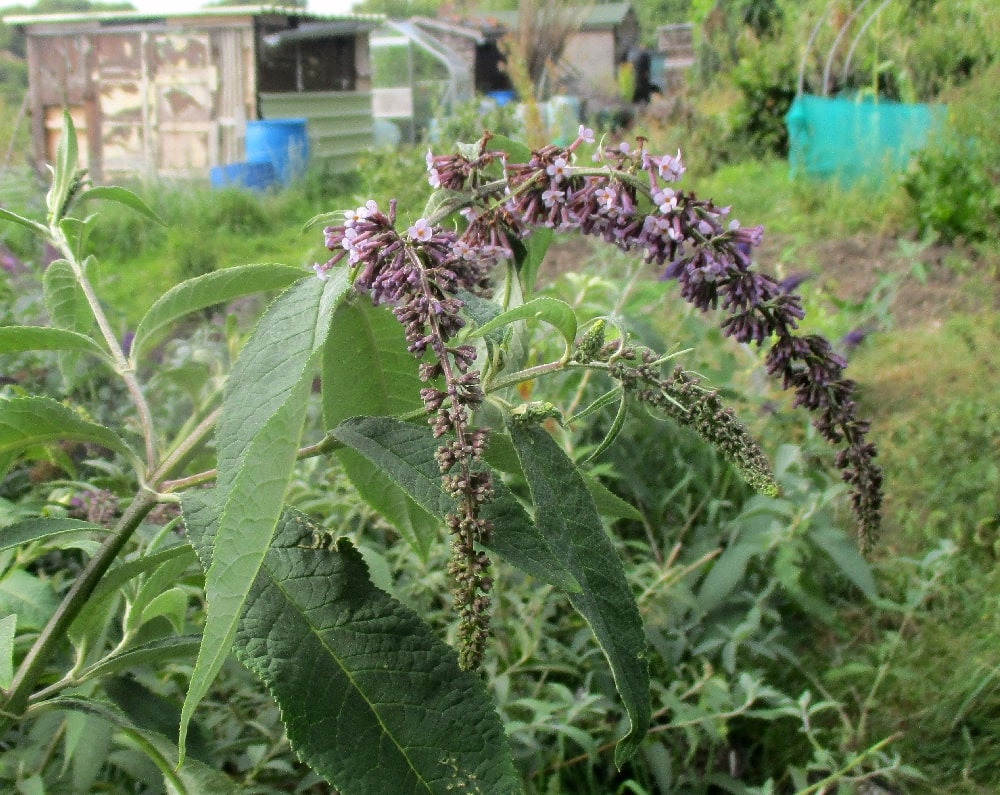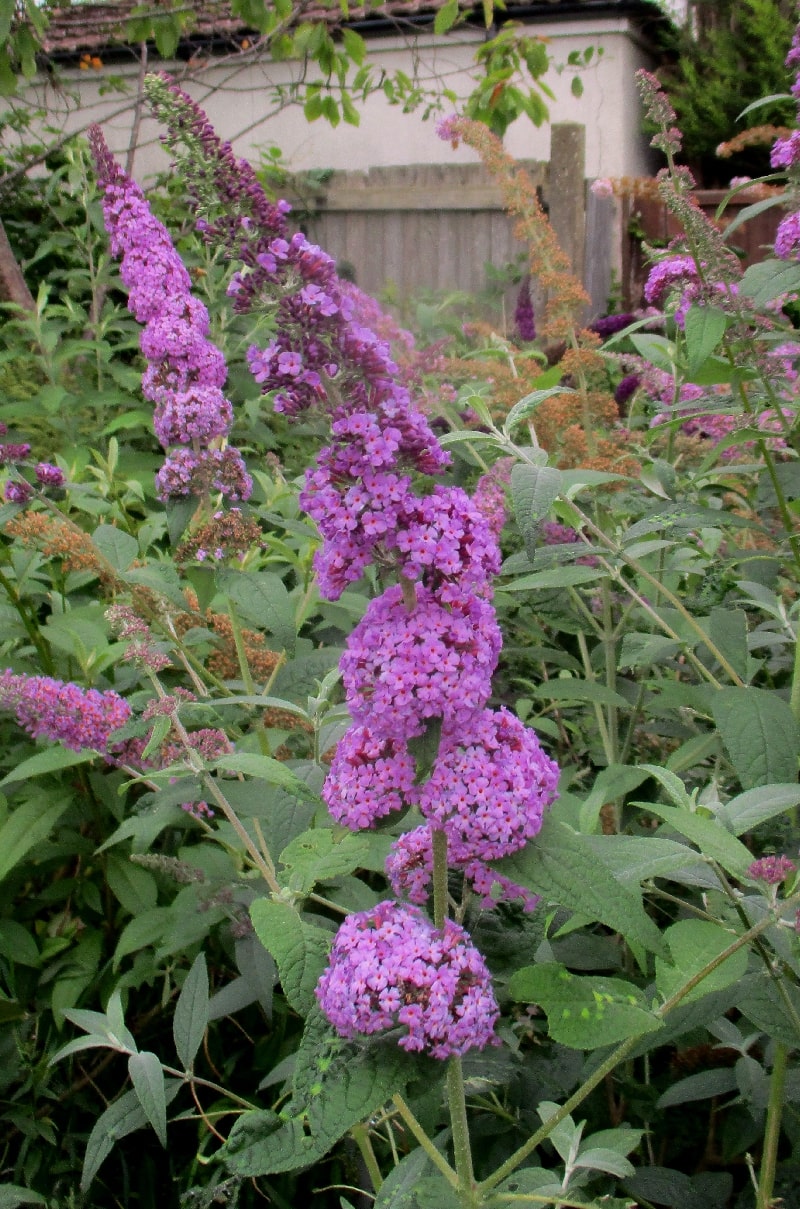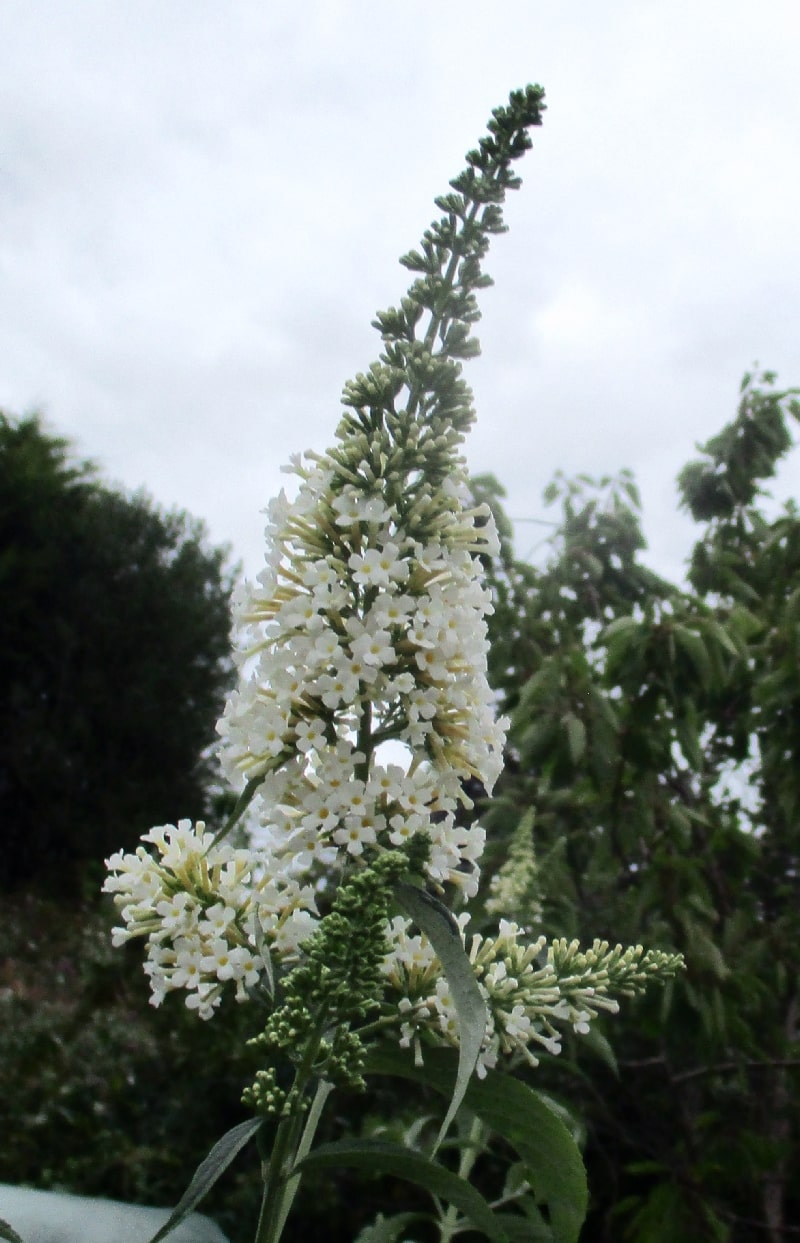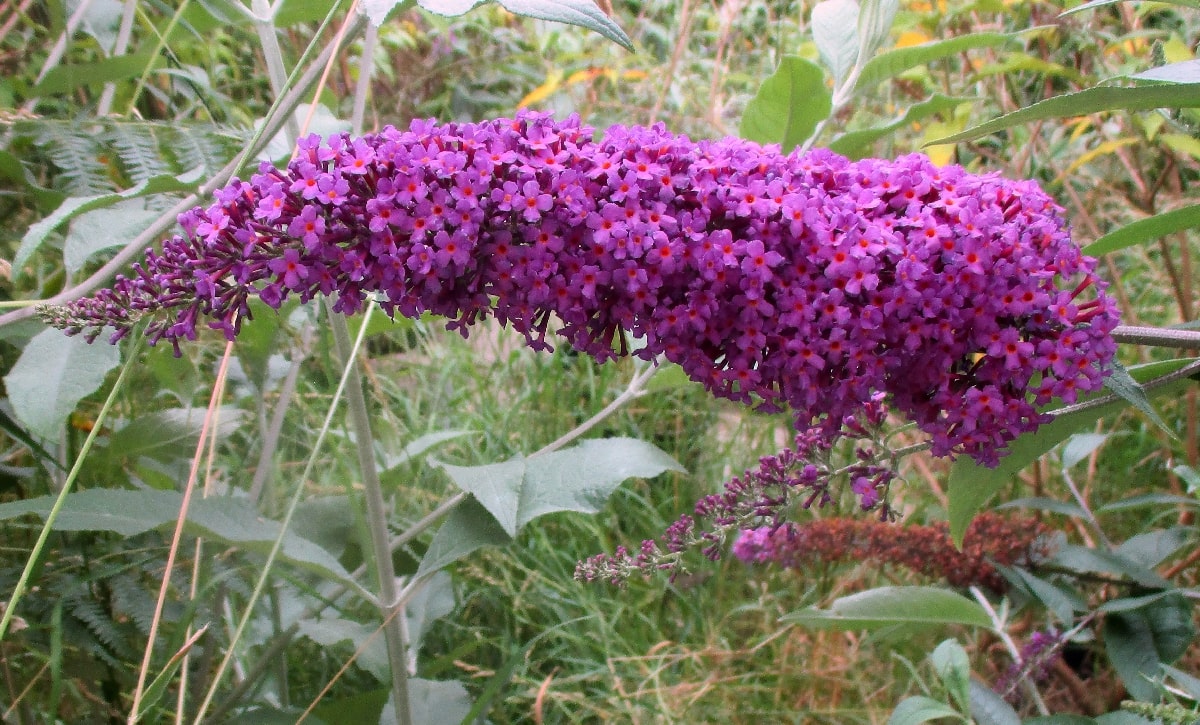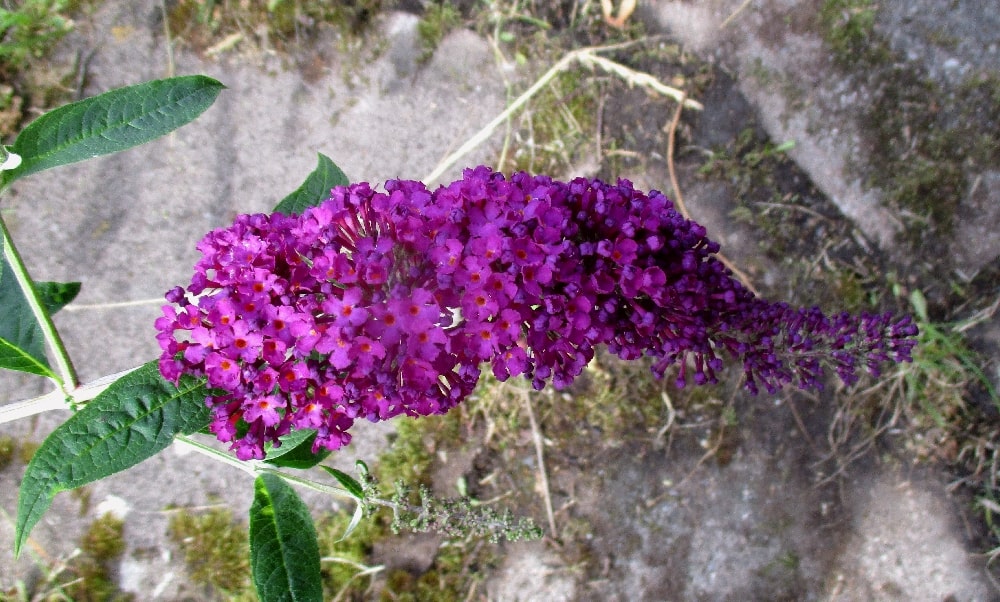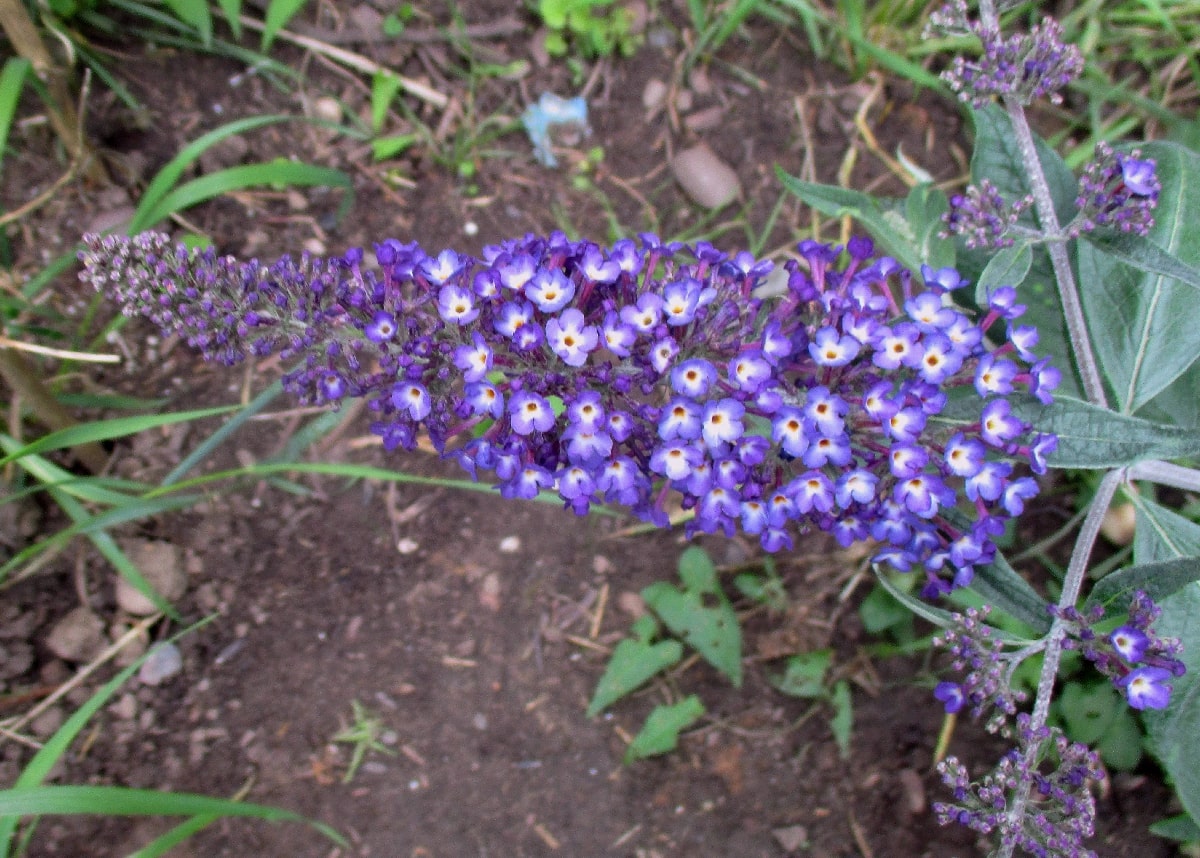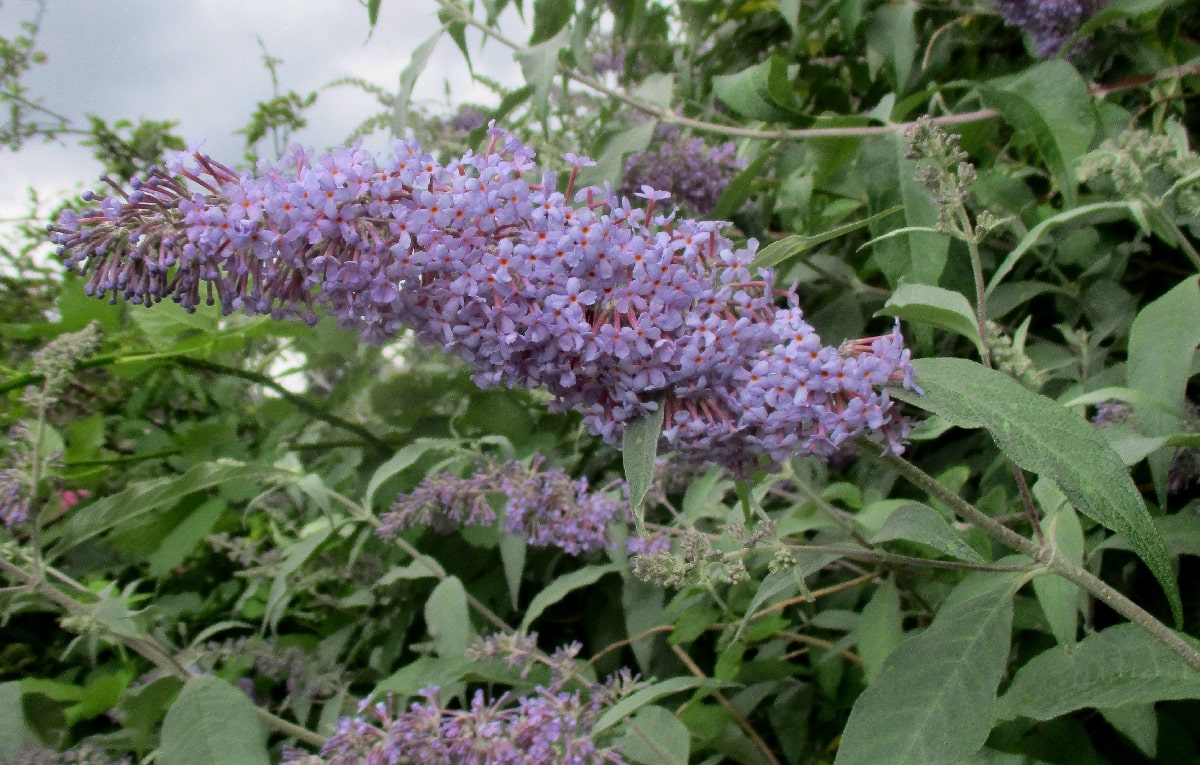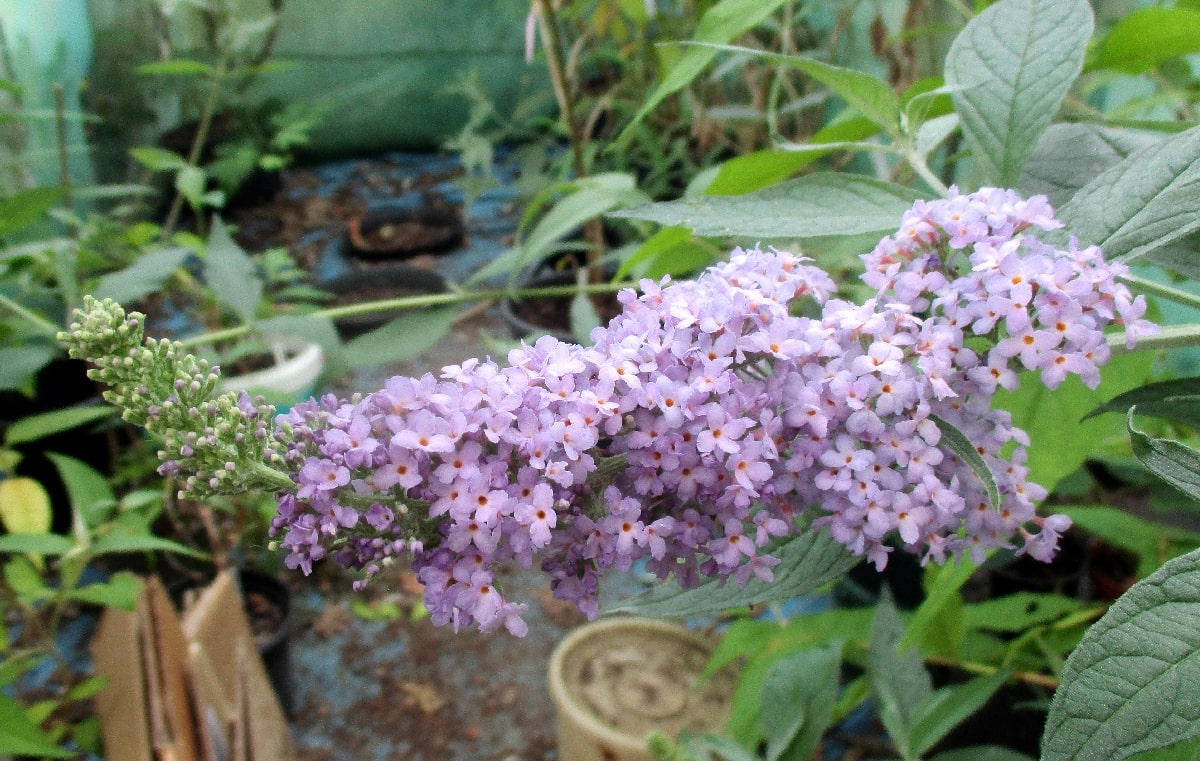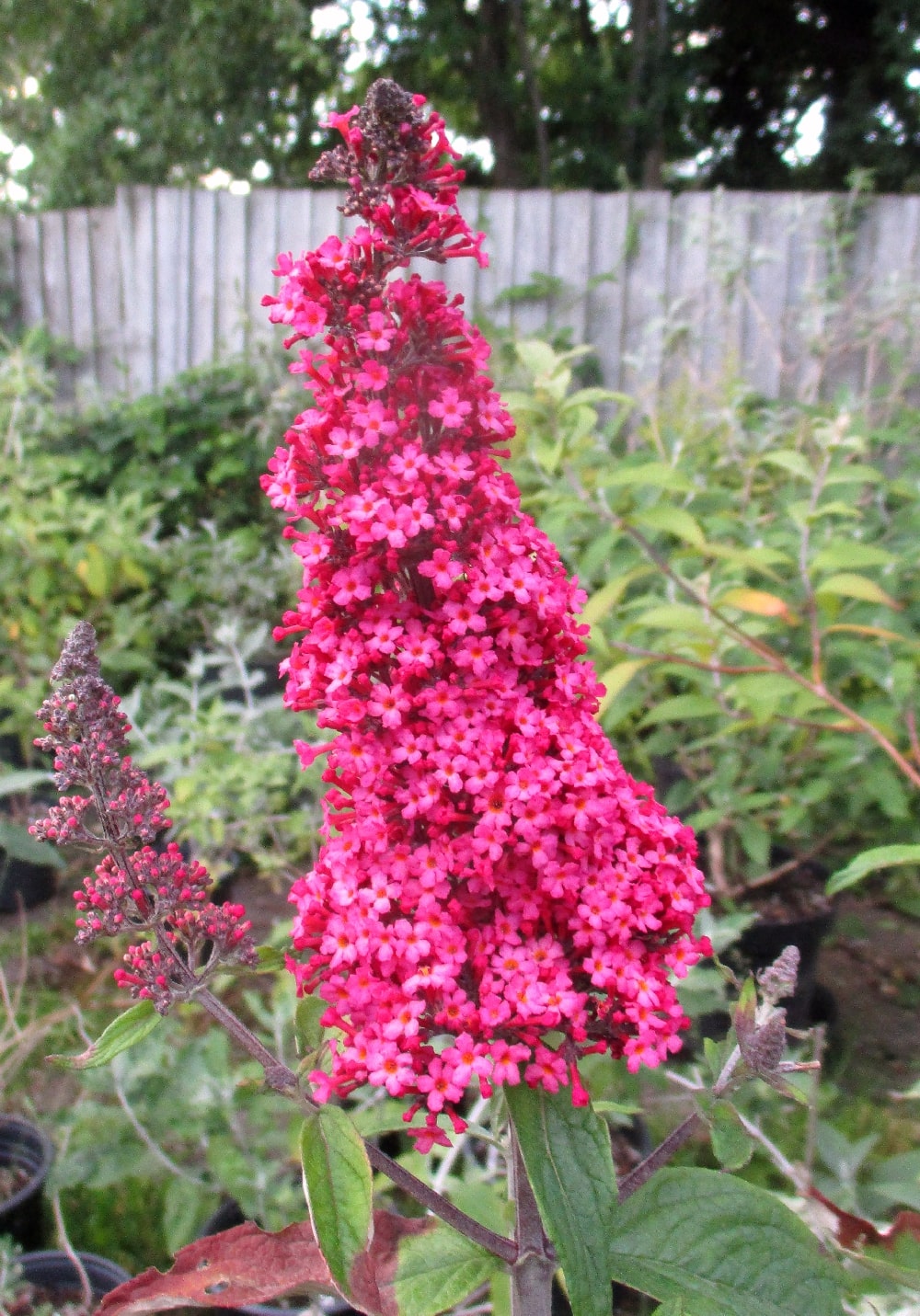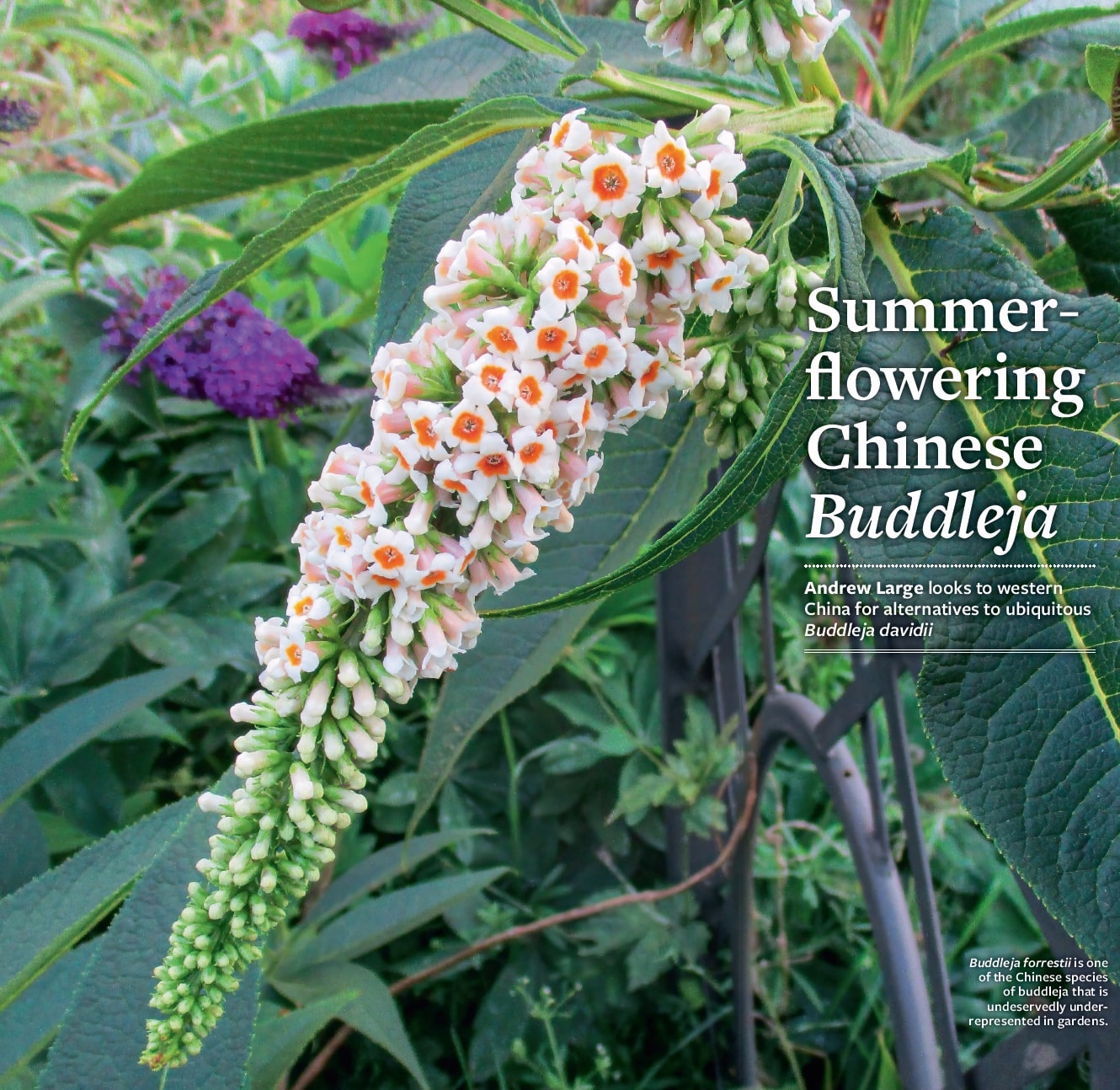
Three-way Hybrid
4th September 2024
I have a rather vigorous seedling of Buddleja forrestii growing on my plot, and from the flowers, which have the stamens about a third of the way into the corolla tube, I can tell it's a hybrid of B. davidii. This hybrid is also extremely fertile.
I raised a couple of its seedlings, most of which have been rejected as gangly, messy plants and often reluctant to flower. The only one I've kept has a better growth habit. Now it's matured I can guess the pollen parent is B albiflora, both from the overall appearance and also because the stamens are in the throat of the albiflora-like flowers. If I didn't know the history, I would probably assume it was a variant B. albiflora.
Buddleja species seem to hybridise endlessly, although the results are usually curiosities with little 'ornamental' value.
A wild Buddleja davidii from China
28th August 2024
I've a few 'native' B. davidii from different locations in China and they differ from one another quite a lot. A paper has been published that systematically looks at the regional variation of B. davidii in China:
Gao Chen, Weichang Gong, Jia Ge, Bruce L. Dunn, and Weibang Sun (2014). Inflorescence scent, colour, and nectar properties of 'butterfly bush' (Buddleja davidii) in its native range. Flora 209: 172-178.
The feral Buddleja that litter our townscapes also show a lot of variation in form and flower-colour. The species was once known as B. variablis to reflect the just how much the species varies.
I grew several seedlings from a seed collection (BO-15-042) made in 2015 by Bjørnar Olsen (Chinese Alpines) in the Chongqing Municipality just east of Sichuan, China. I have still have three plants raised from these seeds, which are now fully mature, and the one shown looks the best.
It's an upright shrub with upright flower panicles. These are quite large and the flower-colour is a pinky-mauve, a typical wild Buddleja shade, but this one is brighter than average. The foliage is dark green and tidy. I would say this is as good a plant as several of the original garden cultivars and a reminder the first cultivars were in fact grown and selected from wild-collected seeds, for example B. davidii var. veitchiana was derived from seed collected by Ernest Wilson in Hubei province early in the 20th century for the Veitch Nursery.
The British feral Buddleja is not much changed from the native plant, except perhaps the leaves have become a little more grey as they've evolved for the UK climate, or perhaps they've picked up a little B. fallowiana DNA from popular hybrid-cultivars like 'Lochinch' or 'West Hill'.
Changing Colours
23rd August 2024
Buddleja curviflora and B. japonica are very closely related species in the Curviflorae series of Buddleja, those with long, curved corolla tubes. These two species readily hybridise, so I have a couple of hybrids of these two species and they appear to be better garden plants than either parent species. A common trait with the Curviflorae species is for the flowers to open purple and then gradually fade to a lighter shade. This hybrid takes it a stage further where some of the flowers fade out completely to white.

This hybrid of B. curviflora and B. japonica has flowers that open purple and then fade to white
Open full size image in a new
window
Hybrids of Hybrids -
an ARGUS® VELVET Seedling
22nd August 2024
The Buddleja ARGUS® plants were bred in Belgium in the noughties and are hybrids of Buddleja lindleyana and B. davidii, 'Nanho Purple' to give us the purple ARGUS® VELVET and 'Nanho White' for ARGUS® WHITE. They are both intermediate between the species, with the flowers having longer, curved corolla tubes like B. lindleyana.
They are both billed as non-invasive, although I've found ARGUS® VELVET produces copious seed in my garden. I can never resist growing the seeds of hybrids, either to prove they're producing viable seed or to see what emerges. And a few years back I grew a batch of seedlings from open-pollinated seed of this hybrid. The seeds were viable and the seedlings robust.
When they came to flower, I could tell they had been pollinated by B. davidii as they'd come to more resemble this species. Mostly, the flowers turned out mauve with just a couple of whites, and the plants rather uninteresting. They were all hardy and vigorous, although sometimes a little shy to flower. I've saved a couple, although I have considered them something of a dead-end in breeding terms.
The best of the batch is a white-flowered plant, and after years in a pot I finally managed to plant it out in a sunny position. It's a tall plant and upright, and promises to be more floriferous than its siblings. The panicles aren't huge, but are well-shaped and the flowers a very clean white with slightly longer corolla tubes. The foliage is dark green and a little more acuminate (i.e.: coming to a point) than B. davidii; this year the leaves are scarred by aphids. It retains just enough B. lindleyana DNA to be visibly something different. I don't yet know how fecund it will prove to be as a fully mature plant.
With plants like these, you have to wait several years to see their final form. Should it prove messy or overly vigorous, I probably won't keep it. If this hybrid performs well and produces fertile seed or pollen, I may even attempt another round of hybridisation.
'Île de France'
14th August 2024
'Île de France' is a rather old cultivar, introduced by A. Nonin (Chantillion-sur-Bagneux. France) in the 1930s. For the RHS Buddleja Trial (2010), at least two different cultivars were submitted under the name. No one knew which one was the authentic 'Île de France' from the 1930s, or if all were spurious.
I found my plant a long time back from a nursery now closed down. Corresponding to the published description of a large shrub with dark green foliage and deep violet flowers, I've been happy to grow it under this name. As you would expect from such an early selection, it's nothing special. The flowers are large and pleasantly scented, but the colour lacks the intensity of modern cultivars.
'Octopus'
7th August 2024
'Octopus' comes from the now discontinued Thompson and Morgan Buddleja breeding programme, once led by Charles Valin. It was to be the start of a series of new Buddleja, code-named 'Buzz 2'. To my knowledge, this is the sole representative to come to market.
Similar in scale to the earlier BUZZ® plants, its USP is the multi-head panicle on a small shrub, and I've found 'Octopus' to be reliable in producing this type of inflorescence. My plant has done well, and is now a metre tall, upright and tidy. The flowers are abundant and a fetching shade of reddish pink-purple.
'Octopus' is rather like a mini 'Camberwell Beauty', although I've never done very well with 'Camberwell Beauty', which is prone to reversion and wind-rock. Thus far, I'm happier with 'Octopus'.
'Fascination'?
2nd August 2024
Something of a mystery, this one. The cultivar 'Fascination' originated in the USA around 1940, and is described as having vivid orchid-pink flowers. Most listings name 'Fascinating' as a synonym, although Stuart (Buddlejas, RHS guide 2006) has them as separate cultivars, with the darker 'Fascinating' originating from Guernsey.
The plant in the National Collections labelled 'Fascination' is purplish, and not at all orchid pink. I suspect it's not the authentic 'Fascination', but rather the plant from Guernsey.
Unpicking the names of cultivars is difficult, as written records are rarely kept and labels lost. And it only takes one mislabelling at a busy nursery for a name to become muddled forever more.
White Ring in
a Dark Flower
1st August 2024
It's been an ambition to produce a flower with a deep purple-blue, a good red-yellow eye (properly known as the throat of the corolla tube) and a regular white ring around the eye. A few years ago I thought I had the perfect plant, but once mature it had a poor rangy growth habit, poor foliage and, although the individual flowers looked good, the flower panicle was often messy and irregular. (Photo here.)
I used that plant to produce seed for another generation. The seedlings proved difficult to raise and took three attempts to bring plants to maturity. Most of the resulting seedlings ended up discarded due to weak colours, lax growth or general weakness. Only couple seemed worth keeping. One is described below (26th July), although its colour is a little pale for my taste.
The other one shown here is a much deeper shade of purplish-blue and the white ring is both regular and consistent in all the flowers. The panicles are a good shape and a reasonable size. The growth habit looks okay and the plant not too vigorous.
I'm still looking to breed more of this form of flower, but I think I've probably taken the white-ring (or 'Orpheus Effect' as I sometimes call it after the first cultivar with this type of flower) as far as I can.
Flowers with White Centres
28th July 2024
For several years I've been trying to perfect the white ring around the eye of in Buddleja flowers. The first cultivar to feature this was 'Orpheus', and a later form called 'Son of Orpheus' increased the extent of the ring.
It's not been easy to improve on the existing plants. I have mostly tried to deepen the colour or increase the ring in order for it to really stand out. It's taken a few generations of in-crossing and out-crossing to achieve a striking flower in a plant with a good growth habit, and I think I'm there at last with a couple of the latest crop.
The flower shown comes from a seedling with good foliage and a reasonable growth habit. The white is quite extensive and the overall effect quite pleasing from a distance. And up close, the flower has an interesting and unique appearance.
Buddleja X 'West Hill'
24th July 2024
There are a handful of B. fallowiana x B. davidii hybrids, and several cultivars with a smaller contribution from B. fallowiana via one of these hybrids. 'West Hill' is one such hybrid, raised at Lochinch Castle, Scotland, c. 1940 and a full sibling of the more popular 'Lochinch'.
'West Hill' is a very big Buddleja with large, grey leaves. The flowers are wishy-washy, pale lilacy-violet. The lax panicles are also rather untidy. It's not one of my favourite Buddleja, and I'm surprised such an untidy monster was awarded an AGM by the RHS.
There is more that can be achieved using B. fallowiana in hybridisation. Better colour flowers, more silvery foliage and compact habits are all possible in a fully hardy and garden friendly Buddleja.
MONARCH® 'Glass Slippers'
19th July 2024
I've a couple of the MONARCH® series of smaller Buddleja. 'Dark Dynasty' has survived outside, but the shrub is rather sparse and not at all the dense growth and floriferous habit promised.
I still have 'Glass Slippers' in a pot because it doesn't look very robust, although I will plant it out next spring. The flowers are a delicate shade, which I would call a very pale violet. The inflorescences have a soft appearance, which I rather like. The foliage is dark green and the plant generally looks healthy at the moment.
But I get the feeling these new Buddleja are selected to meet the needs of the nursery trade, rather than the gardener. Fresh from the nursery in the garden centre, they can look enticing, as they do in all the publicity photographs, but the actual performance in a real setting can be rather disappointing.
HUMDINGER® 'Little Angel'
17th July 2024
The HUMDINGER® series comes from Walters Gardens Inc. (Michigan, USA) and first appeared around 2017. All are claimed to have a small, compact and floriferous habit, and a height and spread of 1 metre. Several of the cultivars have been introduced into the European market, sometimes under the alternative name of POQUITO®. These are second generation mini-Buddleja, and so should perform more reliably than the earlier introductions.
I chose one to trial on my plot. 'Little Angel' has proven itself fairly robust, surviving two winters and some aberrant weather. The plant has stayed small, compact and with a somewhat spreading habit; the foliage is a healthy dark green and the plant overall disease resistant. The flowers are a clean white and the inflorescences are quite small. I wouldn't call it especially floriferous.
This cultivar looks quite good and performs well in a real garden setting, but it's nothing spectacular; it would be all too easily overlooked in a large trial.
The full HUMDINGER® range: 'Gold Drop'; 'Lavender Cupcake'; 'Little Angel'; 'Little Nugget' (retired); 'Magenta Munchkin'; 'Orchid Annie'.
MONARCH® 'Prince Charming'
19th June 2024
The MONARCH® Buddlejas are a series of smaller plants (a maximum of 1.5 metre height and spread) from Walters Gardens Inc., Michigan, USA. The whole series now consists of eleven cultivars of which five or six have been introduced into Europe. Their availability has been patchy in the UK, and only the pink-red 'Prince Charming' has made any impression. Their names are truly cringeworthy, although that's not a valid reason to avoid them.
I've grown 'Dark Dynasty' for a couple of years, and also have 'Glass Slippers'. Recently, I picked up 'Prince Charming', the only one of the series routinely available, because I'd been told it's a unique colour-break. It has flowered now and the colour is striking. I wouldn't call it unique though, as it's in the same part of the spectrum as several other 'red' cultivars. Nevertheless, the shade is impressive and the plant very neat. The flowers do fade to a less intense pink as they go over.
In a pot and kept under cover, 'Prince Charming' looks good, but I do have my concerns it might not stand up to the rigours of the wind and rain we get in the Midlands. 'Dark Dynasty' has stood up reasonably well, but both 'Prince Charming' and 'Glass Slippers' look a little less robust. I'll probably give them another year in a pot and protection over winter before planting them outside.
The full MONARCH® series: 'Cherry Royale' (reddish pink); 'Crown Jewels' (magenta with yellow foliage); 'Dark Dynasty' (deep purple); 'Glass Slippers' (pale lavender-blue); 'Jousting Jester' (orchid pink); 'Prince Charming' (bright cerise-red); 'Princess Bride' (white); 'Princess Pink' (bright pink); 'Royal Falls' (amethyst purple); and 'Queen of Hearts' (magenta).
My Buddleja Article in
The Plant Review
12th June 2024
I was honoured to be asked to submit an article on Buddleja for this quarter's The Plant Review from the RHS, which is considered quite a prestigious magazine. I chose to write about the summer-flowering species of Buddleja from south-western China, with an emphasis on those we can grow in an English garden. The species I've described are Buddleja albiflora, B. colvilei, B. fallowiana, B. forrestii, B. lindleyana, B. macrostachya, B. myriantha, and B. nivea. These species are far from uncommon, but rarely get a mention in the mainstream horticultural press.
These species have become a particular interest of mine. As well as growing multiple collections of some of these species, familiar examples as well as from seeds I've raised and from elsewhere including China, I've also tried my hand at some interspecies hybridisations to see if I can produce hardier cultivars and more appealing garden plants. This is very much a work in progress.
See more about The Plant Review and how to subscribe.
The Editor has very kindly given permission for me to reproduce the article for this website, and the full text can be found here.
Buddleja globosa Breeding
5th June 2024
Last year I described a Buddleja globosa seedling I'd raised, which I called 'Simon' (more details here). 'Simon' is the result of a back-cross of HCM98017, a male plant with pale greenish-yellow flowers, with one of its own offspring, a custard-yellow female called 'Beryl' (more details here). The flowers of 'Simon' are a primrose-yellow and the plant a little more vigorous than the rather sickly HCM98017. 'Simon' has survived the winter and flowered again this spring. Most of his siblings were orange, one a rather fetching shade of tangerine.
One seedling among the siblings of 'Simon' failed to flower last year, but I gave it another chance. The plant looks robust and healthy, and has flowered this season, a little later than the others of the species. It was worth the wait, as the flowers are a good yellow, and perhaps a slightly better colour than 'Simon'.
As far as I can tell, this seedling also has staminate (male) flowers, meaning all eight seedlings I raised from the cross were male. That's rather a nuisance, because it means I have nothing else to raise another generation other than a back-cross to their parent 'Beryl'.
As this appears to be a male plant, I've named it 'Neville'. The next step is to plant 'Neville' out to confirm it's a viable cultivar, and then compare 'Neville' directly with his brother, 'Simon'.
I don't believe there has been much, if any, selective breeding of B. globosa. As far as I know, all examples of the species are from wild collected seed or from randomly pollinated seed produced ex situ. I'm not sure how much genetic variation there is to exploit with the species in any case, and I haven't seen any sports or mutations in the plants I've raised so far. Crosses with the very closely related B. araucana only adds a little into the mix, while other B. globosa hybridisations tend to result in sterile offspring or plants with few of its features.
Edit 4th July 2024
Determining the gender of this species is tricky, and I was certain I could see functional stamens (male part) with pollen. Now, a month later the flowers are forming seed-pods. Whether these are functionally pistillate flowers with visible (but non-functional) stamens or genuinely hermaphrodite flowers is uncertain. I might have to change the name.
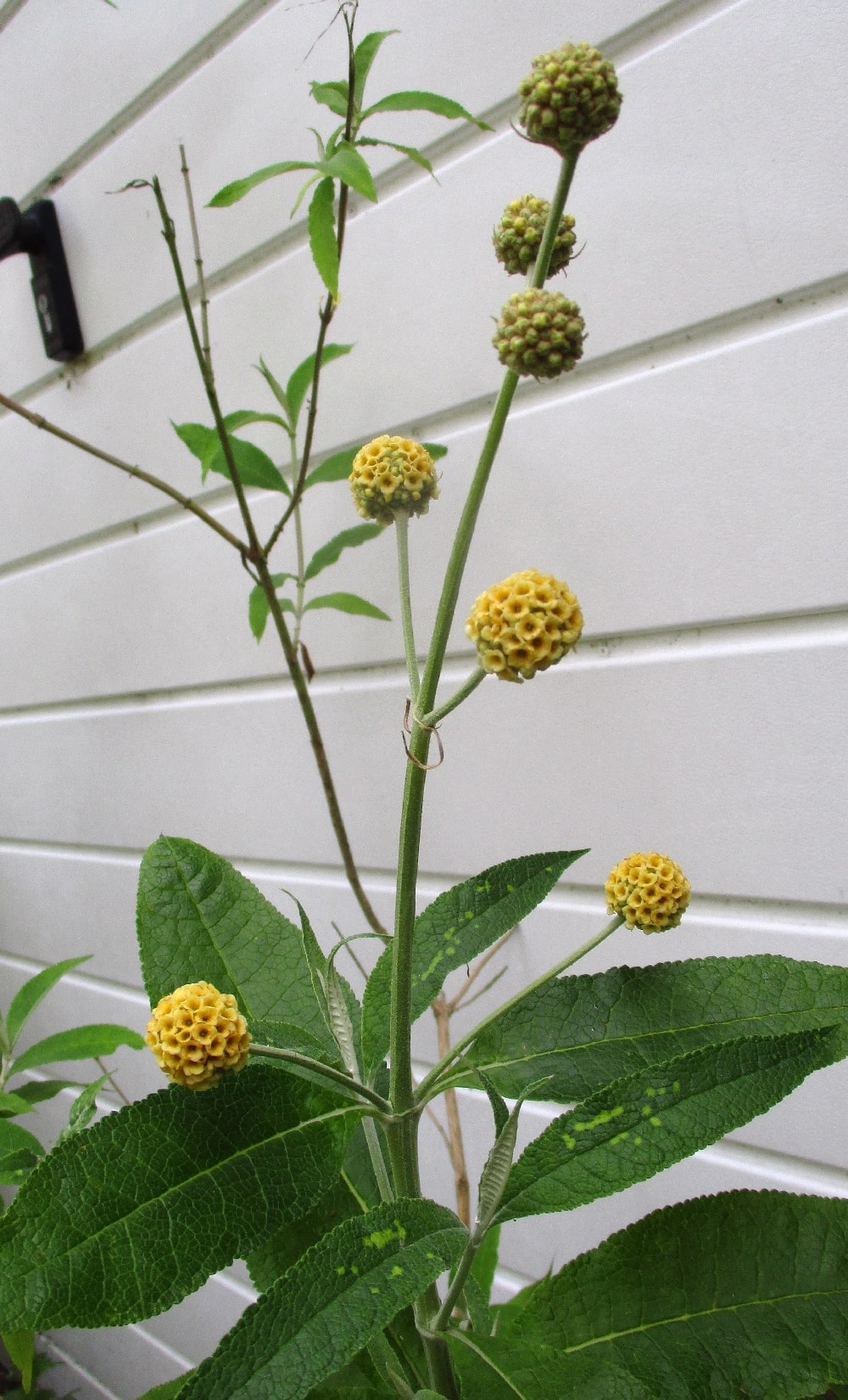
Buddleja globosa 'Neville' is the result of selective breeding
Open full size image in a new
window
Aphids
30th May 2024
I've been getting reports from all over the southern half of England about distorted leaves with yellow lesions on the growing tips of Buddleja. I've had the problem this spring too, especially on plants kept sheltered over the winter and on most species and hybrids. Even feral Buddlejas seem to be affected.
The cause is aphids. Aphids have always fed on Buddleja, low numbers causing little noticeable damage, although these past couple of years the infestations have exploded and the plants seriously affected. It's possible one species of aphid has adapted to take full advantage of this common plant. By the time you see the damage, the aphids have often moved on, so it has not always been easy for people to diagnose the cause of the lesions. Black ants are also spreading the pest from plant to plant and protecting their herd, as they farm the aphids for the honeydew.
I automatically assumed the pest was the mullein aphid (Aphis verbasci), because this species is known to colonise Buddleja. There have been infestations so dense and dark the pest looks more like the black bean aphid (Aphis fabae) you get on broad beans. A close up of the aphids doesn't help much, as these two species look quite similar, but I still err towards the former because they're mostly green in colour. In the photo you can see some are covered in white wax spots.
I blame the mild winter, which has allowed them to get an early start ahead of the emergence of their predators. And then the cold, wet spring has further slowed the advance of the predators. Only now am I seeing ladybirds and hoverfly larvae, and these are attending to the problem without the need for more drastic action. The good news is that plants will recover and the new foliage go back to normal once the aphid population has been sufficiently reduced.
Generally, I avoid all pesticides. For a few precious plants, I resorted to a personal recipe for a spray. I steep garlic and chilli flakes in hot water, and add some horticultural soap. This kills most of the aphids, but you have to spray every day to prevent re-infestation. The spray won't harm the predators and there are no residues to worry the bees and butterflies later in the season.

Aphids have been a nuisance this spring, but now the predators have arrived
Open full size image in a new
window

The aphids under a Buddleja leaf
Open full size image in a new
window
Buddleja araucana
9th May 2024
It's a while since I've had B. arauacana (syn. B. nappii) in flower. My original plant succumbed to the damp; although hardy, this species is demands drier condition compared to B. globosa. The cutting I saved was really slow to get going.
The only available collection is male (staminate) and I have never seen a female (pistillate) flower. However, it readily pollinates B. globosa females to produce hybrids of both genders.
More on this species here: Buddleja globasa and Buddleja araucana page.
Buddleja nivea x
B. forrestii Hybrid
24th April 2024
It's been very wet winter and spring; some of my plants have really suffered from the wet and the waterlogging. There is more than the usual amount of dieback on several B. davidii cultivars and even a couple of losses. On the other hand, the winter weather has also been mild and some species like B. forrestii and B. macrostachya have thrived. These two species in particular do not like summer drought and seem to prefer moister soil.
Like many people, I'm also suffering an infestation of aphids on some Buddlejas kept under cover. I've caught ants spreading the aphids to new plants, so they're being deliberately farmed! Time for a spray made of horticultural soap and garlic: the soap to kill the aphids; the garlic to deter the ants. I'd never use an insecticide on a Buddleja as the residues would find their way into the nectar in the summer.
One plant that is looking particularly interesting at the moment is a B. nivea x B. forrestii (type: limitanea) hybrid I raised a few years back. Most B. nivea hybrids resemble the species and have a tendency to be tall and rangy, with long internodes. They also become rather woody low down with all the foliage towards the top. My hybrids of this type have usually proved too vigorous or too ugly to keep.
This one is more compact at about a metre and a half, and the internodes are short, which means the foliage is dense. The young leaves are quite furry and the stems have retained the snowy-white tomentum of the parent. The plant pictured is now five or six years old and still hasn't required significant pruning. It's yet to reach for the sky, so I'm reasonably confident it is, in fact, genuinely compact.
The appeal is as a foliage plant. The flowers are only a marginal improvement on the rather insignificant flowers of B. nivea, and are a pinky-mauve. Like the parent species, it flowers July to September.
I've not tested the viability of its seeds, although it does produce plenty of seed capsules and the flowers appear to shed pollen. Many of the B. nivea hybrids I've raised have proved to be fully fertile, although none of the seedlings have so far proved to have any merit as an ornamental. I do feel there is potential for further breeding to develop a hybrid with the interesting foliage of B. nivea, a good growth habit and showy flowers, and I'm hoping this plant may be a step in the right direction. Now, what to cross it with this summer?

This hybrid has an excellent growth habit
Open full size image in a new
window
<>
And the internodes are short
Open full size image in a new
window
Email:
buddlejagarden@gmail.com
© The Buddleja Garden 2011-2025.

